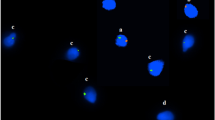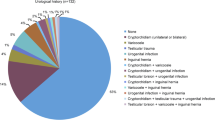Abstract
Purpose: To evaluate the frequencies of sex chromosome aneuploidy and diploidy rate of epididymal spermatozoa from obstructive azoospermic men and its impact on intracytoplasmic sperm injection (ICSI) outcomes.
Methods: Epididymal spermatozoa retrieved from 24 obstructive azoospermic men and ejaculated spermatozoa from 24 fertile donors were analyzed using triple color fluorescence in situ hybridization (FISH) techniques, in order to investigate the rates of diploidy and aneuploidy for chromosomes 18, X and Y.
Results: Epididymal spermatozoa from obstructive azoospermic men had total sex aneuploidy, disomy 18, and diploidy rates significantly higher than ejaculated spermatozoa from normozoospermic fertile controls (1.44% vs. 0.14%, 0.11% vs. 0.02%, and 0.18% vs. 0.02%, respectively; p < 0.005). There were no statistically significant differences in ICSI outcomes between the patients who had high and low epididymal sperm aneuploidy rate.
Conclusions: Epididymal spermatozoa from obstructive azoospermic patients had an elevated sex chromosome aneuploidy and diploidy rate. The increased frequency of chromosomal abnormalities did not have a direct effect on the ICSI outcome.
Similar content being viewed by others

References
JohnsonMD: Genetic risks of intracytoplasmic sperm injection in the treatment of male infertility: Recommendations for genetic counseling and screening. Fertil Steril 1998;70:397–411
Van OpstalD, LosFJ, RamlakhanS, Van HemelJO, Van Den OuwelandAM, BrandenburgH, PietersMH, VerhoeffA, VermeerMC, DhontM, In't VeldPA: Determination of the parent origin in nine cases of prenatally detected chromosome aberrations found after intracytoplasmic sperm injection. Hum Reprod 1997;12:682–686
BonduelleM, CamusM, De VosA, StaessenC, TournayeH, Van AsscheE, VerheyenG, DevroeyP, LiebaersI, Van SteirteghemA: Seven years of intracytoplasmic sperm injection and follow-up of 1987 subsequent children. Hum Reprod 1999;14:243–264
LoftA, PetersenK, ErbK, MikkelsenAL, GrinstedJ, HaldF, HindkjaerJ, NielsenKM, LundstromP, GabrielsenA, LenzS, HornnesP, ZisbeS, EjdrupHB, LindhardA, ZhouY, Nyboe AndersenA: A Danish national cohort of 730 infants born after intracytoplasmic sperm injection (ICSI) 1994–1997. Hum Reprod 1999;14:2143–2148
AboulgharH, AboulgharM, MansourR, SerourG, AminY, Al-InanyH: A prospective controlled study of karyotyping for 430 consecutive babies conceived through intracytoplasmic sperm injection. Fertil Steril 2001;76:249–253
PangMG, HoegermanSF, CuticchiaAJ, MoonSY, DoncelGF, AcostaAA, KearnsWG: Detection of aneuploidy for chromosomes 4, 6, 7, 8, 9, 10, 11, 12, 13, 17, 18, 21, X and Y by fluorescence in-situ hybridization in spermatozoa from nine patients with oligoastheno-teratozoospermia undergoing intracytoplasmic sperm injection. Hum Reprod 1999;14:1266–1273
Ushijima1C, KumasakoY, KihailePE, HirotsuruK, UtsunomiyaT: Analysis of chromosomal abnormalities in human spermatozoa using multi-colour fluorescence in-situ hybridization. Hum Reprod 2000;15:1107–1111
Van DykQ, LanzendorfS, KolmP, HodgenGD, MahonyMC: Incidence of aneuploid spermatozoa from subfertile men: Selected with motility versus hemizona-bound. Hum Reprod 2000;15:1529–1536
RubioC, Gil-SalomM, SimonC, VidalF, RodrigoL, MinguezY, RemohiJ, PellicerA: Incidence of sperm chromosomal abnormalities in a risk population: Relationship with sperm quality and ICSI outcome. Hum Reprod 2001;16:2084–2092
BernardiniL, GianaroliL, FortiniD, et al.: Frequency of hyper-, hypohaploidy and diploidy in ejaculate, epididymal and testicular germ cells of infertile patients. Hum Reprod 2000;15:2165–2172
LevronJ, Aviram-GoldringA, MadgarI, RavivG, BarkaiG, DorJ: Sperm chromosome abnormalities in men with severe male factor infertility who are undergoing in vitro fertilization with intracytoplasmic sperm injection. Fertil Steril 2001;76:479–484
World Health Organization: WHO Laboratory Manual for the Examination of Human Semen and Sperm–Cervical Mucus Interaction, 4th edn. Cambridge, England, Cambridge University Press, 1999
SukcharoenN, SithipravejT, PromviengchaiS, BoonkasemsantiW: Sperm morphology evaluated by computer (IVOS) in prediction of fertilization rate in vitro after intracytoplasmic sperm injection (ICSI). Fertil Steril 1998;69:564–568
SukcharoenN, SithipravejT, PromviengchaiS, BoonkasemsantiW: Comparison of the fertilization rate after intracytoplasmic sperm injection (ICSI) using ejaculated sperm, epididymal sperms, and testicular sperms. J Med Assoc Thai 1998;81:565–571
SukcharoenN, SithipravejT, PromviengchaiS, BoonkasemsantiW: No differences in outcome of surgical sperm retrieval with ICSI in different post-vasectomy intervals. Fertil Steril 2000;74:174–175
WyrobekAJ, AlhbornT, BalhornR, StankerL, PinkelD: Fluorescence in situ hybridization to Y chromosomes in decondensed human sperm nuclei. Mol Reprod Dev 1990;34:308–313
BlancoJ, EgozcueJ, VidalF: Incidence of chromosome 21 disomy in human spermatozoa as determined by fluorescent in-situ hybridization. Hum Reprod 1996;11:722–726
MartinRH, RademakerA: Reliability of aneuploidy estimates in human sperm: Result of fluorescence in situ hybridization studies using two different scoring criteria. Mol Reprod Dev 1995;42:89–93
WyrobekAJ: Methods and concepts in detecting abnormal reproductive outcomes of paternal origin. J Reprod Toxicol 1993;7:3–16
VegettiW, Van AsscheE, FriasA, VerheyenG, BianchiMM, BonduelleM, LiebaersI, Van SteirteghemA: Correlation between semen parameters and sperm aneuploidy rates investigated by fluorescence in-situ hybridization in infertile men. Hum Reprod 2000;15:351–365
AranB, BlancoJ, VidalF, VendrellJM, EgozcueS, BarriPN, EgozcueJ, VeigaA: Screening for abnormalities of chromosomes X, Y, and 18 and for diploidy in spermatozoa from infertile men participating in an in vitro fertilizationintracytoplasmic sperm injection program. Fertil Steril 1999;72:699–701
CalogeroAE, De PalmaA, GraziosoC, BaroneN, RomeoR, RappazzoG, D'AgataR: Aneuploidy rate in spermatozoa of selected men with abnormal semen parameters. Hum Reprod 2001;16:1172–1179
MartinRH, GreeneC, RademakerA, BarclayL, KoE, ChernosJ: Chromosome analysis of spermatozoa extracted from testes of men with non-obstructive azoospermia. Hum Reprod 2000;15:1121–1124
VivilleS, WarterS, MeyerJM, WittnmerC, LriotM, MollardR, JacqminD: Histological and genetic analysis and risk assessment for chromosomal aberration after ICSI for patients with CABVD. Hum Reprod 2000;15:1613–1618
PalermoGD, ColomberoLT, HariprashadJ, SchlegelPN, RosenwaksZ: Chromosome analysis of epididymal and testicular sperm in azoospermic patients undergoing ICSI. Hum Reprod 2002;17:570–575
ColomberoLT, HariprashadJJ, TsaiMC, RosenwaksZ, PalermoGD: Incidence of sperm aneuploidy in relation to semen characteristics and assisted reproductive outcome. Fertil Steril 1999;72:90–96
Author information
Authors and Affiliations
Rights and permissions
About this article
Cite this article
Sukcharoen, N., Ngeamvijawat, J., Sithipravej, T. et al. High Sex Chromosome Aneuploidy and Diploidy Rate of Epididymal Spermatozoa in Obstructive Azoospermic Men. J Assist Reprod Genet 20, 196–203 (2003). https://doi.org/10.1023/A:1023674110940
Issue Date:
DOI: https://doi.org/10.1023/A:1023674110940



